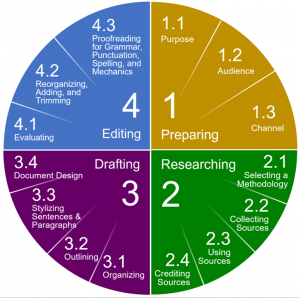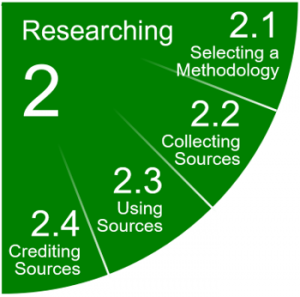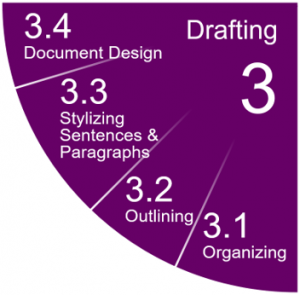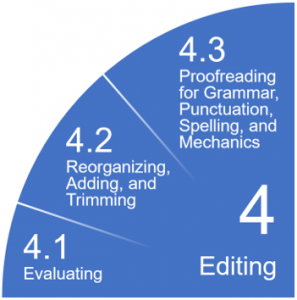The Writing Process
Introduction

There are several ways to think about the writing process. Some of these contain a few steps, some a lot. The names and amounts of the steps themselves are not that important; the important thing is to make sure you are working through the process. Like communication in general, good writing comes from following a process. Between an author hatching an idea and the audience

reading and understanding that idea, the writing process enables the author to craft messages in a time-efficient manner that ultimately meets the needs of the audience. Without following a four-stage process from (1) preparing to (2) information gathering, (3) drafting, to (4) editing through to sending the message, an author can waste plenty of their own time writing what doesn’t need to be written and wasting the reader’s time by confusing them with a message that doesn’t meet their needs. The next chapters deal with various aspects and steps of the writing process. Because researching is such an important part of the drafting process, this textbook has created a separate section just for research in order to discuss it to the extent that it deserves. For now, a quick overview of the research, drafting, and editing steps.

Before researching, you’ll have identified your purpose for writing, profiled your audience, and selected the appropriate channel. Next, you must gather the information that your audience needs. From the shortest informative email to the sprawling analytical report, most professional messages involve relaying information that was looked up—that is, they involve research. Employers value employees who are resourceful and whose research skills go well beyond Google searching on the internet and focusing on the top few results as anyone can do. Whether such in-demand employees get the needed information from a print book in a library, a manual from a database on a company intranet, an article from a subscription database on the internet, or simply by asking a reputable authority such as a veteran co-worker, they prove their value by knowing where to find valuable information, how to use it appropriately, and how to document it if necessary.

Now that you’ve planned out your document and gathered information that meets your audience’s needs, you’re just about ready to start drafting the document’s message. At this point, it’s worthwhile reminding yourself that the words you start entering in your word processor will look different from those your reader will eventually read. By the end of the drafting stage examined in this section, your document will be partway there, but how much revising you do in the fourth stage depends on how effectively you’ve organized your message in the first step of this third stage.
Once done with drafting, you’re on to the revision and editing stage. This part gets tricky, but whatever you do, don’t quit now! Self-correction is an essential part of the writing process, one that students or professionals skip at their peril. Say you’ve just dashed off a quick email. Glancing back to ensure that it’s correct in terms of its grammar, punctuation, spelling, and mechanics helps you avoid confusing your reader or embarrassing yourself. Those errors can be like stains on your shirt or rips in your uniform: they give the impression that you’re incompetent or uncaring—qualities no employers respect because it suggests a lack of attention to detail.

Always keep in mind that people generalize to equate the quality of your writing with the quality of your work. Because readers tend to be judgmental, they may even draw bigger conclusions about your level of education, work ethic, and overall professionalism from even a small writing sample. Especially with résumés and cover letters where your words are the first impression employers have of you, employers are judgmental about your writing because customers can be. Employers don’t want you to represent their company to customers in a way that makes it look like the whole organization does shoddy, amateur work.
The final stage of the writing process is thus managing your readers’ impressions by editing your draft from beginning to end. This involves first returning to your headspace at the start of the writing process and assessing where your document is in relation to the purpose you set out to achieve for it. When you get a sense of how far your document is from achieving that primary purpose, you realize what needs to be done to close that gap—what you need to add, rewrite, delete, and improve. Your next move is a two-step editing process of substantial revisions and proof-editing. The order of these is crucial to avoid wasting time. You wouldn’t proofread for minor grammatical errors before substantial revisions because you may end up just deleting altogether paragraphs that you meticulously proofread with a fine-tooth comb.
LICENSE AND ATTRIBUTION
Adapted from Julie River’s “Chapter 2: The Writing Process I: Preparing” of Communication at Work, 2020, used according to CC by 4.0. Access for free at https://ecampusontario.pressbooks.pub/comm1062/part/chapter-2-the-writing-process-1-preparing/
Adapted from Julie River’s “Chapter 3: The Writing Process 2: Research” of Communication at Work, 2020, used according to CC by 4.0. Access for free at https://ecampusontario.pressbooks.pub/comm1062/part/chapter-2-the-writing-process-1-preparing/
Adapted from Julie River’s “Ch. 4 The Writing Process 3: Drafting” of Communication at Work, 2020, used according to CC by 4.0. Access for free at https://ecampusontario.pressbooks.pub/comm1062/part/chapter-4-the-writing-process-3-drafting/
Adapted from Julie River’s “Ch. 5 The Writing Process 3: Editing” of Communication at Work, 2020, used according to CC by 4.0. Access for free at https://ecampusontario.pressbooks.pub/comm1062/part/chapter-4-the-writing-process-3-drafting/
